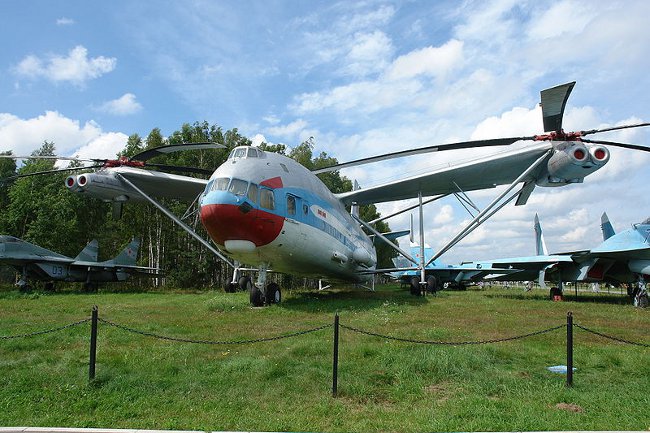| Picture |

|
| Manufacturer |
Mil
|
| Type |
Mi-12 / Homer
|
| Introduced |
7/10/1968
|
| In production? |
No
|
| Units produced |
2
|
| Price US $ |
0.00
|
| Overall Length |
121.4 ft
|
| Length |
121.4 ft
|
| Height |
41 ft
|
| Width |
220 ft
|
| |
|
| |
|
| Description |
The Mil Mi-12 (NATO designation, Homer) is a very heavy lift helicopter. It uses two main rotors that each spin in opposite directions. The engines and rotors were mounted on two relatively small wings. The model was capable of lifting a huge amount of cargo. It took a flight crew of six to operate this flying machine. Similar to the heavy lifter Mi-10, the Mi-12 also uses the engine, transmission and rotor system from the Mi-6. There were two prototypes built, the first of which flew in 1967. It took until 1973 before the second one joined the test program. However, the Mi-12 never entered into production due to its very high unit costs and because better alternatives were emerging in the early 1970s. In particular, the Mi-26, which was based on a conventional helicopter layout with a much improved transmission and engine technology, would turn out to be a 'leaner' and more effective solution to the heavy lifting challenge. All this rendered the Mi-12 obsolete before it could even enter into service.
|
| Advertisement |
|
| Design features |
- Uses Mi-6 dynamic system (rotors, transmission and engines)
- Engine and rotor groups carried on wings
- Fixed, twin wheel, tricycle landing gear
- Semi-monocoque fuselage
- Large rear clamshell doors
|
|
The Mil Mi-12 (NATO designation, Homer) is a very heavy lift helicopter. It uses two main rotors that each spin in opposite directions. The engines and rotors were mounted on two relatively small wings. The model was capable of lifting a huge amount of cargo. It took a flight crew of six to operate this flying machine. Similar to the heavy lifter Mi-10, the Mi-12 also uses the engine, transmission and rotor system from the Mi-6. There were two prototypes built, the first of which flew in 1967. It took until 1973 before the second one joined the test program. However, the Mi-12 never entered into production due to its very high unit costs and because better alternatives were emerging in the early 1970s. In particular, the Mi-26, which was based on a conventional helicopter layout with a much improved transmission and engine technology, would turn out to be a 'leaner' and more effective solution to the heavy lifting challenge. All this rendered the Mi-12 obsolete before it could even enter into service.
|
|
- Advertisement -
|
Design features:
- Uses Mi-6 dynamic system (rotors, transmission and engines)
- Engine and rotor groups carried on wings
- Fixed, twin wheel, tricycle landing gear
- Semi-monocoque fuselage
- Large rear clamshell doors
|
| Persons |
250
|
| Max. Range |
500 mi
|
| Cruise Speed |
149 mph
|
| Max. Speed |
161 mph
|
| Max. rate of Climb |
0 ft/min
|
| HOGE ceiling |
0 ft
|
| Service Ceiling |
11500 ft
|
| Gross Weight |
213848 lb
|
| Empty Weigt |
132277 lb
|
| Useful Load |
81571 lb
|
| Fuel Capacity |
0 gallons
|
| Number of Engines |
4
|
| Engine Type |
Turbine
|
| Engine Code |
Soloviev D-25VF
|
| Horse Power |
6500
|
| Rotorhead |
Fully articulated
|
| Number of rotorblades |
2
|
| Rotor Diameter |
114.8 ft
|
| Number of tail rotorblades |
0
|
| Tailrotor Diameter |
0 ft
|
|